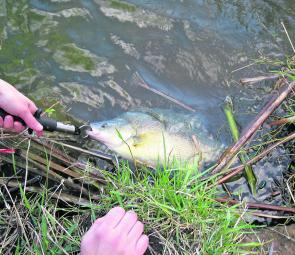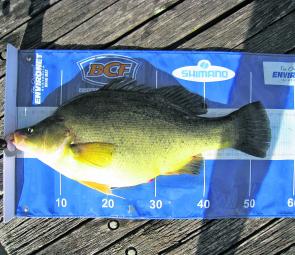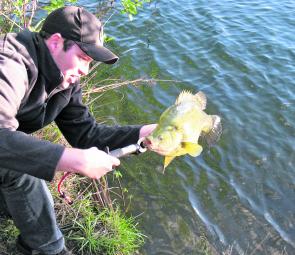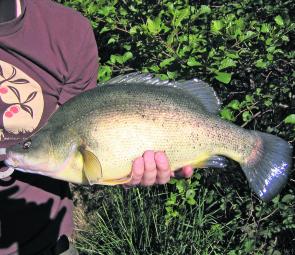When spring rolls around I like to get out and catch a few big fish early on in the season. Getting a few quick points on the board is important because it helps build my confidence again after the leaner winter months.
Golden perch are the perfect fish to chase when you’re looking to tighten your game because they are a strong adversary on light gear, providing exciting runs and powerful head shakes. Bait fishing for these bars of gold in September and October is a great way to spend an afternoon on the water and will help hone your skills for the coming summer onslaught.
Golden perch (also known as yellowbelly or callop) are a powerful native fish which are closely related to Murray cod and display similar behaviours with their giant relation. Once they have matured, yellowbelly leave the school behind, set up residence in a large snag and ambush anything that has the nerve to pop its head in. Their eyesight is similar to humans and so a lure flicked past their nose will often get a response.
It is also important to note that golden perch have an incredible sense of smell. The large nostril openings (nares) near the eye are a dead giveaway. Because of this keen sense of smell, they respond well to bait. Using bait will bring the perch to you and, depending on where you are fishing, often in strong numbers.
Springtime provides a wonderful opportunity to get outside and have a look around lakes and rivers for golden perch. After a good dump of rain near the end of winter it’s important to go for a walk around likely areas to look for structure and, if you’re an experienced angler, to look for changes to significant snags such as logs and rocks. The rising water levels and warmer weather will get the perch on the chew so it’s important to have an idea of where they may be residing.
I don’t baitfish for goldens in amongst the timber. I find these snags to be incredibly frustrating for two reasons: one being the constant re-rigging and the other being that if I do get a large fish, there is high chance that it will wrap my line on the first run.
Instead, when baitfishing for these wily natives in spring I focus on weed beds. I find that I can get a lot of fish by focusing on these areas and I don’t get the same number of snags. Schooling perch can often hold quite deep but larger specimens will seek shallow water once they come of size. Therefore, a weed bed presents the perfect environment for them – shaded, shallow and full of food. Perch will often sit just outside or just inside the weed bed, depending on what kind of food they are looking for.
I recently took a group of fishos out at the start of spring who had struggled to catch a perch throughout summer and autumn. They were shocked when I parked myself beside a weed bed because there was no other discernible structure. After two yellas came into the net I left them (and their smiling faces) to it!
When you find a likely weed bed, make sure you berley the area. I use a mix of chopped scrub worms, Ultrabite, yabby tails and bread. It is important to berley throughout the session so as to take advantage of the goldens’ extraordinary sense of smell.
When I find a new weed bed I first test its length before fishing. I use a treble hook without anything attached, and just cast it out and retrieve it I hit the weed bed. Then I just wrench it free. It is important to note where the weed bed begins and ends because the productive zone is about a metre out from the weeds on the structure-less, sandy bottom.
I use scrub worms and yabbies (no more than 3” long) when casting out near the weed beds. Yabbies which you have collected yourself from the same area are best, as are worms, but most good fishing tackle shops carry live bait. To create a scent trail, crush the claws of the yabbies and leave them attached, or cut the very end off the scrub worms.
Golden perch will find their way to your bait easily enough, but once they arrive it’s important to make your offering irresistible. Cast out and wait a few minutes for the surface to settle again and for the bait to come to rest on the bottom. Golden perch have good hearing through their lateral line (a series of highly sensitive sensory organs on their flanks) and can become spooked upon hearing a rig hit the water, so give it a few minutes before doing anything too drastic.
Once you have given everything time to settle, twitch the bait up off the bottom. This is not a tug nor a strike but rather just a flick of the wrist. A subtle movement like this will imitate a yabby or worm stirring up the bottom. If your bait moves more than 10cm or so, you have put too much into it.
A lot of golden perch specialists insist that keeping the bait off the bottom using a freshwater paternoster rig is the right way to connect with a fish but I have found that by twitching the bait off the bottom, I’m tapping into two of the perch’s senses and maximising the chance of a bite, while also ensuring that the bait has settled and is almost forgotten until the first twitch. This technique works really well on enormous golden perch who might be a little lethargic at the start of spring. Once you have twitched the bait a few times and are starting to get close to the weed bed, reel in and repeat the process.
When you are winding in you may find that a yellowbelly follows your bait right up to your feet. If you see one doing this, stop winding and let the bait float back down through the water column. Sometimes this can induce a strike.
If this doesn’t result in a hook-up you can switch over to a lure/scrub worm or lure/yabby combination. This involves substituting a running sinker rig for a paternoster style hook set-up, but with a difference. At the bottom of the line where you’d normally put a sinker, you put on a shallow diving lure. I’ve been using this technique more and more and it has been producing some superb results. This technique truly does appeal to both the goldens’ sense of smell and keen eyesight. I think it sees the lure as chasing the bait. Wind slowly if you employ this method.
If you’re fishing from a boat you can try the ‘yo-yo’ method. As the name implies, this involves dropping the bait near the edge of the weed and encouraging the perch to strike by working the bait up and down in a yo-yo motion. You can also try this from pontoons or bridges – pretty much anywhere where you can get over a weed bed.
If you want to maximise your hook-ups and conversions you’ll want to invest in a quality rod and reel for this type of fishing. Golden perch load up a rod in a unique way. The strike is extremely powerful and the first run can be hard to stop. The head shakes can also make life interesting. If you’re fishing with a rod that has a stiff blank, the initial strike will result in nothing more than a bust-off. The strike is quick so there needs to be a bit of play in the tip. If the fish feels too much pressure it will let go.
A good native rod is very tippy while having an extraordinary amount of power in the butt. Once I started taking this type of fishing seriously, I did some research and came across the Daiwa Tournament Master Z range and specifically, the Flats Master which is a medium/light rod. This series was built by Daiwa for chasing Australian native species and designed by Brad Sissins with the help of rod engineers from Japan. Another good option is the Daiwa Battler Thunderstorm, a great all-round rod for this type of fishing, and Gary Howard is also making some amazing stuff at the moment. Ultimately, no matter which brand you go for, look for a rod that has been designed for working crankbaits because bait fishing for perch is very similar to working these types of lures.
When it comes to reels, I use a Daiwa Sol II 2508 loaded with 8lb braid and 16lb leader. This is another reason why it is important to have a tippy rod – braid has no stretch and so a good rod tip will act almost like the stretch. The 2508 doesn’t have a particularly deep spool but you don’t need one. Golden perch are capable of three or four big runs and then will usually come to the net. It is important to have an excellent drag system rather than a deep spool.
I use a running sinker rig with 30cm of 16lb line separating swivel and hook. A small ball sinker that allows you to cast a reasonable distance is more than sufficient. Mustad size 6 baitholder hooks are a good choice because they are small and a yellowbelly does not have a particularly large mouth.
Searching for golden perch in spring is by far and away my favourite form of fishing. I don’t have to work too hard to connect with a stonker, and at times the action can be thick and fast which makes for an exciting warm up for the summer months. So instead of reaching for a box of lures and walking/paddling/motoring kilometre after kilometre in search of a spring native, why not let the fish come to you by throwing a few baits out near the edge of a weed bed?
Reads: 2248








